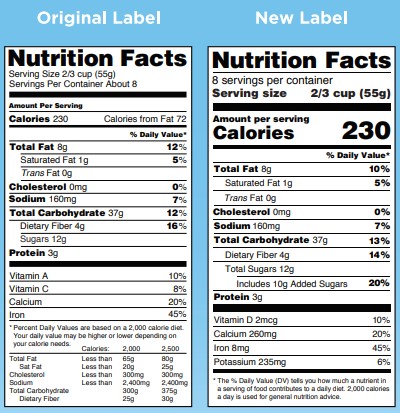Changing food labels in the US
The FDA’s deadline for clearer Nutrition Facts labels for large manufacturers has been and gone. Designed to better highlight the nutritional content of packaged products, the labels will now focus much more clearly on high calorie and sugar content per standard serving size – information some manufacturers may not want to showcase. Although small and simple, these changes could have a significant impact on consumer perception of a range of products, influencing their decision to buy and leading many manufacturers to consider the need to reformulate.
Updated Nutrition Facts label
In May 2016, the FDA (US Food and Drug Administration) published the final rules regarding the new Nutrition Facts label for packaged foods in the US, the first change in 20 years. The new regulation will allow consumers to make more informed choices about the foods they buy, ultimately aiming to reduce heart disease and obesity within the US. Manufacturers making >$10 million in annual sales must have switched to the new label by January 1, 2020; those of <$10 million sales have until January 1, 2021, and foods imported to the United States will also need to comply. According to the FDA, it’s estimated that these changes could impact 60,000 manufacturers, costing the industry $2 billion, yet it’s expected that the regulations will yield $20-30 billion in economic benefits after implementation.
The main change that manufacturers will have to adhere to is a clearer and more consistent labelling format, with the number of calories and serving sizes made much bigger and bolder. Outdated serving sizes must be updated to represent the amount consumers are eating in reality today, making it much easier for them to calculate their calorie intake. What’s more, products that are likely to be eaten in one serving should display calorie and nutrient information for the whole product to give consumers an accurate picture of their nutritional intake, while multi-serve packs will have a dual column to show per serving and whole package nutritional information to try to encourage consumers to carefully consider how much they want to eat.
Daily values for nutrients, such as sodium, dietary fiber and vitamin D, have been updated based on newer scientific evidence. The daily values are reference amounts of nutrients to consume (or not to exceed) and are used to calculate the %DV. Vitamin D and potassium content will have to be displayed in grams, as these are known deficiencies in the US diet. The type of fat present, whether it is saturated or trans fat, will also be made clearer. In addition, the %DV of added sugars in the product will now be listed on the label, making consumers aware of how the product will affect their recommended daily allowance, and hopefully help them to reduce their intake.
Switched on consumers
The changing Nutrition Facts label coincides with a study by Northwestern Medicine, which found that the United States packaged food and beverage supply in 2018 was generally ultra-processed and unhealthy as more than 70% of the 230,156 products analyzed were classified as ultra-processed. Yet despite the potential lack of choice, with shelves packed with processed products, many consumers are becoming savvier and paying more attention to labels of the foods they’re eating. Claims such as ‘low calorie’, ‘low fat’ and ‘no added sugars’ are key buzzwords that many consumers seek out, yet it seems some manufacturers haven’t yet tapped into this health & wellness trend.
In order to adhere to new labelling requirements to protect consumer health, ensure consumers keep buying their products and attract health-conscious customers, manufacturers need to reformulate. But how can you reduce calories and maintain the taste consumers have grown to love? The answer is Steam Infusion.
Reformulation to the rescue
Reformulation using Steam Infusion technology allows manufacturers of soups , sauces and dairy-based products to cut down on less desirable ingredients, such as fat, while maintaining or even improving the flavor of the end product. Thanks to the speed of cook (Steam Infusion heats 2,204lb of product from 60°F to 195°F in under 10 minutes), manufacturers can retain the creaminess or fatty flavors so products are still delicious – they just don’t contain as many calories!
For example, Steam Infusion can achieve a 20% reduction in fat whilst maintaining an indulgent and luxurious mouthfeel because the unique Steam Infusion processing environment manipulates starch to form a fat mimetic which enhances the creamy mouthfeel, enabling a reduction in overall fat content.
The study from Northwestern Medicine also found that the US food supply is similarly healthy to that of other countries, e.g. Australia, but the products tend to be more processed with higher median sugar and sodium content. Steam Infusion is able to enhance the flavor profile of many products while reducing the need for such high quantities of salt or sugar, allowing manufacturers to reduce these ingredients while maintaining the taste that consumers love and come to expect.
Reformulation isn't just about changing one part of the process, we need to look at it holistically and work with recipes using the expertise of our in-house development chef. Some recipes will have opportunities for substantial reductions whilst others won't. That's why we encourage our customers to test Steam Infusion on their recipes, either taking part in trials at our test center at the University of Lincoln or testing a Steam Infusion Vaction™ Pump on-site with your ingredients and the support of our NPD experts.




